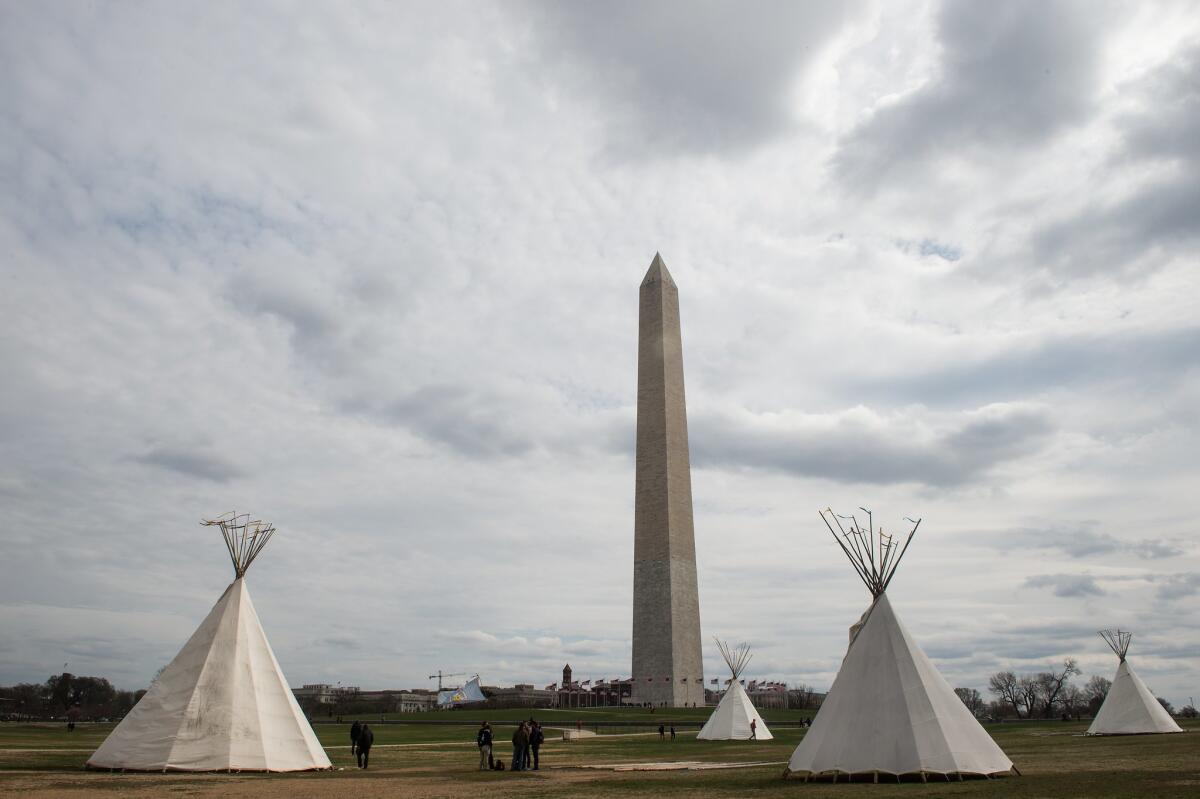Oil could begin flowing through Dakota Access pipeline as early as next week

The Dakota Access pipeline could begin transporting oil as soon as next week after a judge on Tuesday rejected the latest effort to prevent its completion and operation.
U.S. District Judge James E. Boasberg in Washington denied a request by the Cheyenne River Indian tribe to halt construction on grounds that the pipeline violated its members’ religious freedom. The tribe had claimed that the pipeline was “a terrible Black Snake prophesied to come into the Lakota homeland and cause destruction” by desecrating water used in religious ceremonies.
Both the Cheyenne River and the Standing Rock Sioux tribes’ reservations border Lake Oahe, a dammed section of the Missouri River under which the final leg of the $3.8-billion, 1,170-mile pipeline is now being completed. The tribes have argued for months that the pipeline threatens sacred cultural sites and their water supply, which is drawn from the lake.
Yet after months of protests, hundreds of arrests and many legal challenges, the pipeline, which would transport more than 500,000 barrels of crude oil daily from western North Dakota to an existing pipeline in Patoka, Ill., is all but certain to become operational this month, according to the company building it, Energy Transfer Partners.
“We are pleased with Judge Boasberg’s decision today to deny the motion by the Cheyenne River Sioux tribe,” the company said in a statement. “We have progressed quickly with the final piece of construction under Lake Oahe in North Dakota and anticipate that oil will be introduced to this part of the line the week of March 13 or the week of March 20, but it is more likely to occur the week of March 13.”
Last month, the U.S. Army Corps of Engineers and the Bureau of Indian Affairs cleared the sprawling protest camps near Lake Oahe that once were occupied by thousands of people.
Boasberg rejected the Cheyenne River tribe’s religious claim in part because it had not previously raised specific concerns about the “Black Snake prophecy” in more than two years of contact with the Army Corps of Engineers over the pipeline and worries that it threatened water and would damage sacred sites. While his ruling was specific to a request for a temporary injunction to stop construction, Boasberg said the claim was unlikely to succeed on its merits.
A lawyer for the tribe, Nicole Ducheneaux, said Tuesday her clients were disappointed and that the ruling “demonstrates a continued misunderstanding of American Indians’ religious beliefs.” She said the effort to stop construction was “just the beginning of a much broader legal fight.”
Jan Hasselman, a lawyer for the Standing Rock Sioux, said Tuesday that the tribe would continue to challenge the pipeline on issues including whether the Army Corps of Engineers adequately considered the tribes’ treaty rights when it issued the decision to grant an easement for the pipeline to travel beneath the lake.
Although the pipeline’s route does not travel on reservation land, it does cross an area granted to Sioux Indians under treaties they signed with the government in the 1850s and 1860s. Hasselman said the tribe had “a treaty right” to safe drinking water.
Hasselman also said the tribe would challenge the Trump administration’s decision not to pursue a more vigorous environmental review ordered in the final weeks of the Obama administration. President Trump, in one of his first actions as president, instructed the Army Corps of Engineers to reverse that plan.
Hasselman said he hoped Boasberg would hold a hearing in April on those and other issues raised by the tribe. If the judge eventually were to rule in the tribe’s favor, the pipeline could be “turned back off,” Hasselman said.
The ruling came on the same day that members of Native American groups and others began four days of protests in Washington that include setting up tepees on the National Mall. The protests are expected to culminate with a march to the White House on Friday.
UPDATES:
3:35 p.m.: The story was updated throughout with staff reporting.
The story was originally published at 10:25 a.m.
More to Read
Start your day right
Sign up for Essential California for news, features and recommendations from the L.A. Times and beyond in your inbox six days a week.
You may occasionally receive promotional content from the Los Angeles Times.







